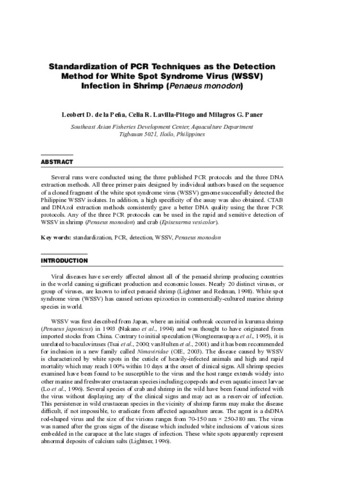Sandfish (Holothuria scabra) as potential reservoir of white spot syndrome virus (WSSV) when co-cultured with black tiger prawn (Penaeus monodon)
- Global styles
- MLA
- Vancouver
- Elsevier - Harvard
- APA
- Help

URL ที่เชื่อมโยง
eafpbulletin.scholasticahq.comวันที่
2024-03-08ผู้เขียน
Page views
667AGROVOC keyword
Taxonomic term
Geographic names
เมตาดาต้า
แสดงระเบียนรายการเต็ม
Share
นามธรรม
Since the first occurrence of White Spot Disease (WSD) in 1992, it is still listed as one of the crustacean diseases by the World Organisation for Animal Health in 2022. Horizontal transmission in co-culture systems is one of the usual modes in the spread of the disease. WSD outbreak was recorded during the experimental run of the co-culture of black tiger prawn (Penaeus monodon) and sandfish (Holothuria scabra) in the grow-out phase. In this study, artificial infection through two cohabitation experiments were conducted to determine if H. scabra is a potential non-crustacean vector or reservoir of WSSV. Samples were checked using one-step and nested PCR for increased readout sensitivity of virus infection to investigate the horizontal transmission between prawn and sandfish. During the first cohabitation (5 days) where WSSV (+) prawn were cohabited with WSSV (-) sandfish, 100% of the prawn were one-step PCR positive for WSSV while 100% of the sandfish were nested PCR positive. Subsequently, WSSV (+) sandfish from the first cohabitation were transferred to another tank to be cohabited with WSSV (-) prawn. Sampling of both prawn and sandfish was done every 6 days post-infection (dpi). At 6 to 18 dpi, prawn and sandfish were nested PCR positive. At 25 dpi, there were no prawns left due to mortality and 1 of the 3 remaining sandfish was nested PCR positive. Based on the results, it elucidates the ability of sandfish to bioaccumulate the viral particles when cohabited with WSSV (+) prawn. Results suggest that WSSV is viable in the sandfish confirming its potential as a vector or reservoir due to the consistent nested PCR positive results of the prawn during the second cohabitation. Hence, it can be inferred that sandfish can be a potential non-crustacean vector or reservoir of WSSV for a limited period of time.
การอ้างอิง
de la Peña, L. D., Caber, D. B., Villacastin, A. J. B., Cabillon, N. A. R., Arboleda, J. I., Castellano, J. L. A., Nava, J. K. P. T., & Watanabe, S. (2024). Sandfish (Holothuria scabra) as potential reservoir of white spot syndrome virus (WSSV) when co-cultured with black tiger prawn (Penaeus monodon). Bulletin of the European Association of Fish Pathologists. https://doi.org/10.48045/001c.94283
Type
ArticleISSN
0108-0288คอลเลกชัน
- Journal Articles [1256]
Related items
Showing items related by title, author, creator and subject.
-
Standardization of PCR techniques as the detection method for white spot syndrome virus (WSSV) infection in shrimp (Penaeus monodon)
de la Peña, Leobert D.; Lavilla-Pitogo, Celia R.; Paner, Milagros G. (Aquaculture Department, Southeast Asian Fisheries Development Center, 2005-03)Several runs were conducted using the three published PCR protocols and the three DNA extraction methods. All three primer pairs designed by individual authors based on the sequence of a cloned fragment of the white spot ... -
White spot syndrome virus (WSSV) risk factors associated with shrimp farming practices in polyculture and monoculture farms in the Philippines
White spot sydrome virus (WSSV) is one of the most important viral disease of shrimp. Several studies to control the disease have been done. Tank experiments identified WSSV risk factors related to the physico chemical ... -
Induction of immunity and resistance to white spot syndrome virus (WSSV) in shrimp Penaeus monodon (Fabricius) by synthetic oligodeoxynucleotide and bacterial DNA
Shrimps like all invertebrates are believed to lack true adaptive immunity but recent evidence indicate that they can be protected against pathogenic organisms by priming their immune system with immunostimulatory substances. ...








